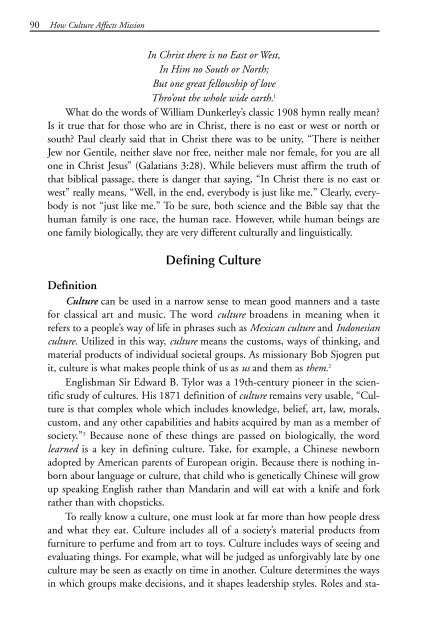discovering missions - Southern Nazarene University
discovering missions - Southern Nazarene University
discovering missions - Southern Nazarene University
Create successful ePaper yourself
Turn your PDF publications into a flip-book with our unique Google optimized e-Paper software.
245187 Disc Missions ins 9/6/07 1:04 PM Page 90<br />
90 How Culture Affects Mission<br />
In Christ there is no East or West,<br />
In Him no South or North;<br />
But one great fellowship of love<br />
Thro’out the whole wide earth. 1<br />
What do the words of William Dunkerley’s classic 1908 hymn really mean?<br />
Is it true that for those who are in Christ, there is no east or west or north or<br />
south? Paul clearly said that in Christ there was to be unity, “There is neither<br />
Jew nor Gentile, neither slave nor free, neither male nor female, for you are all<br />
one in Christ Jesus” (Galatians 3:28). While believers must affirm the truth of<br />
that biblical passage, there is danger that saying, “In Christ there is no east or<br />
west” really means, “Well, in the end, everybody is just like me.” Clearly, everybody<br />
is not “just like me.” To be sure, both science and the Bible say that the<br />
human family is one race, the human race. However, while human beings are<br />
one family biologically, they are very different culturally and linguistically.<br />
Defining Culture<br />
Definition<br />
Culture can be used in a narrow sense to mean good manners and a taste<br />
for classical art and music. The word culture broadens in meaning when it<br />
refers to a people’s way of life in phrases such as Mexican culture and Indonesian<br />
culture. Utilized in this way, culture means the customs, ways of thinking, and<br />
material products of individual societal groups. As missionary Bob Sjogren put<br />
it, culture is what makes people think of us as us and them as them. 2<br />
Englishman Sir Edward B. Tylor was a 19th-century pioneer in the scientific<br />
study of cultures. His 1871 definition of culture remains very usable, “Culture<br />
is that complex whole which includes knowledge, belief, art, law, morals,<br />
custom, and any other capabilities and habits acquired by man as a member of<br />
society.” 3 Because none of these things are passed on biologically, the word<br />
learned is a key in defining culture. Take, for example, a Chinese newborn<br />
adopted by American parents of European origin. Because there is nothing inborn<br />
about language or culture, that child who is genetically Chinese will grow<br />
up speaking English rather than Mandarin and will eat with a knife and fork<br />
rather than with chopsticks.<br />
To really know a culture, one must look at far more than how people dress<br />
and what they eat. Culture includes all of a society’s material products from<br />
furniture to perfume and from art to toys. Culture includes ways of seeing and<br />
evaluating things. For example, what will be judged as unforgivably late by one<br />
culture may be seen as exactly on time in another. Culture determines the ways<br />
in which groups make decisions, and it shapes leadership styles. Roles and sta-

















